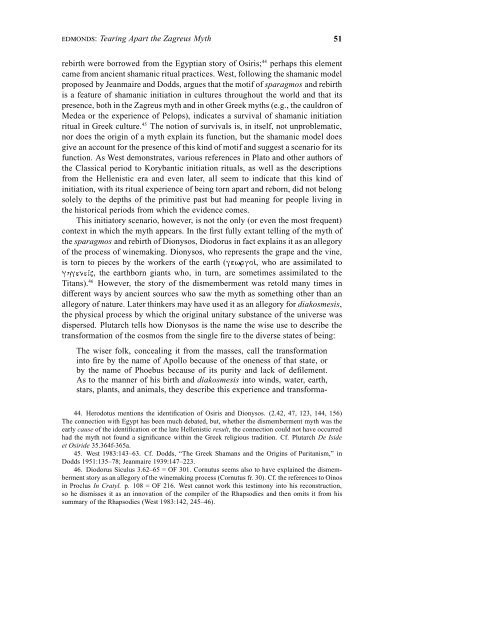Tearing Apart the Zagreus Myth - Bryn Mawr College
Tearing Apart the Zagreus Myth - Bryn Mawr College
Tearing Apart the Zagreus Myth - Bryn Mawr College
Create successful ePaper yourself
Turn your PDF publications into a flip-book with our unique Google optimized e-Paper software.
EDMONDS: <strong>Tearing</strong> <strong>Apart</strong> <strong>the</strong> <strong>Zagreus</strong> <strong>Myth</strong> 51<br />
rebirth were borrowed from <strong>the</strong> Egyptian story of Osiris; 44 perhaps this element<br />
came from ancient shamanic ritual practices. West, following <strong>the</strong> shamanic model<br />
proposed by Jeanmaire and Dodds, argues that <strong>the</strong> motif of sparagmos and rebirth<br />
is a feature of shamanic initiation in cultures throughout <strong>the</strong> world and that its<br />
presence, both in <strong>the</strong> <strong>Zagreus</strong> myth and in o<strong>the</strong>r Greek myths (e.g., <strong>the</strong> cauldron of<br />
Medea or <strong>the</strong> experience of Pelops), indicates a survival of shamanic initiation<br />
ritual in Greek culture. 45 The notion of survivals is, in itself, not unproblematic,<br />
nor does <strong>the</strong> origin of a myth explain its function, but <strong>the</strong> shamanic model does<br />
give an account for <strong>the</strong> presence of this kind of motif and suggest a scenario for its<br />
function. As West demonstrates, various references in Plato and o<strong>the</strong>r authors of<br />
<strong>the</strong> Classical period to Korybantic initiation rituals, as well as <strong>the</strong> descriptions<br />
from <strong>the</strong> Hellenistic era and even later, all seem to indicate that this kind of<br />
initiation, with its ritual experience of being torn apart and reborn, did not belong<br />
solely to <strong>the</strong> depths of <strong>the</strong> primitive past but had meaning for people living in<br />
<strong>the</strong> historical periods from which <strong>the</strong> evidence comes.<br />
This initiatory scenario, however, is not <strong>the</strong> only (or even <strong>the</strong> most frequent)<br />
context in which <strong>the</strong> myth appears. In <strong>the</strong> first fully extant telling of <strong>the</strong> myth of<br />
<strong>the</strong> sparagmos and rebirth of Dionysos, Diodorus in fact explains it as an allegory<br />
of <strong>the</strong> process of winemaking. Dionysos, who represents <strong>the</strong> grape and <strong>the</strong> vine,<br />
is torn to pieces by <strong>the</strong> workers of <strong>the</strong> earth (gewrgoÐ, who are assimilated to<br />
ghgeneØj, <strong>the</strong> earthborn giants who, in turn, are sometimes assimilated to <strong>the</strong><br />
Titans). 46 However, <strong>the</strong> story of <strong>the</strong> dismemberment was retold many times in<br />
different ways by ancient sources who saw <strong>the</strong> myth as something o<strong>the</strong>r than an<br />
allegory of nature. Later thinkers may have used it as an allegory for diakosmesis,<br />
<strong>the</strong> physical process by which <strong>the</strong> original unitary substance of <strong>the</strong> universe was<br />
dispersed. Plutarch tells how Dionysos is <strong>the</strong> name <strong>the</strong> wise use to describe <strong>the</strong><br />
transformation of <strong>the</strong> cosmos from <strong>the</strong> single fire to <strong>the</strong> diverse states of being:<br />
The wiser folk, concealing it from <strong>the</strong> masses, call <strong>the</strong> transformation<br />
into fire by <strong>the</strong> name of Apollo because of <strong>the</strong> oneness of that state, or<br />
by <strong>the</strong> name of Phoebus because of its purity and lack of defilement.<br />
As to <strong>the</strong> manner of his birth and diakosmesis into winds, water, earth,<br />
stars, plants, and animals, <strong>the</strong>y describe this experience and transforma-<br />
44. Herodotus mentions <strong>the</strong> identification of Osiris and Dionysos. (2.42, 47, 123, 144, 156)<br />
The connection with Egypt has been much debated, but, whe<strong>the</strong>r <strong>the</strong> dismemberment myth was <strong>the</strong><br />
early cause of <strong>the</strong> identification or <strong>the</strong> late Hellenistic result, <strong>the</strong> connection could not have occurred<br />
had <strong>the</strong> myth not found a significance within <strong>the</strong> Greek religious tradition. Cf. Plutarch De Iside<br />
et Osiride 35.364f-365a.<br />
45. West 1983:143–63. Cf. Dodds, “The Greek Shamans and <strong>the</strong> Origins of Puritanism,” in<br />
Dodds 1951:135–78; Jeanmaire 1939:147–223.<br />
46. Diodorus Siculus 3.62–65 = OF 301. Cornutus seems also to have explained <strong>the</strong> dismemberment<br />
story as an allegory of <strong>the</strong> winemaking process (Cornutus fr. 30). Cf. <strong>the</strong> references to Oinos<br />
in Proclus In Cratyl. p. 108 = OF 216. West cannot work this testimony into his reconstruction,<br />
so he dismisses it as an innovation of <strong>the</strong> compiler of <strong>the</strong> Rhapsodies and <strong>the</strong>n omits it from his<br />
summary of <strong>the</strong> Rhapsodies (West 1983:142, 245–46).
















